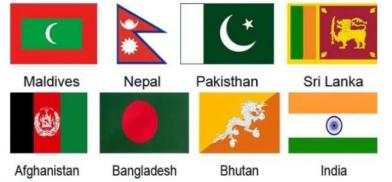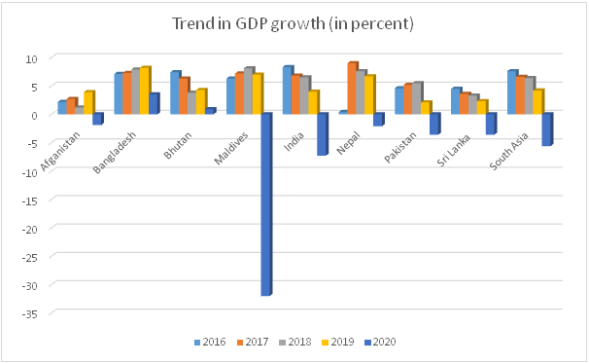South Asian government needs to relax fiscal austerity, promote high-skill, high value-added sectors
The most important challenge for South Asia is to revive livelihoods, which the crisis has devastated across the region, writes Partha Pratim Mitra for South Asia Monitor

The Asian Development Bank (ADB) has in its September 2021 update lowered its 2021 economic growth outlook for developing Asia, which includes South Asia. ADB has forecast growth of 7.1 percent this year, while the growth outlook for 2022 is raised to 5.4 percent from 5.3 percent. (see table 1)
New variants of the Covid-19 virus have renewed prospects of local outbreaks, resulting in the reintroduction of restrictions and lockdowns at various levels. The recovery in the growth rate of GDP between 2020 and 2021 according to the forecasts is expected to be the sharpest for the South Asia region as compared to other regions of Developing Asia. The recovery will, however, depend considerably on how fast the growth momentum in the region picks up, which would, in turn, depend on the progress of Covid-19 vaccination, growth of the domestic economy, the revival of tourism and exports.
Table 1: Regional GDP Forecast(in percent)

Note: 0.1(0.2+0.5)-Developing Asia , 0.2 Central Asia, 0.3 East Asia, 0.4 South Asia,.0.5-The Pacific,0,6-South east Asia AO-April Outlook .U-September Update ,Figures for 2021 and 2022 are forecasts
Source: Asian Development Outlook(ADO), Sep 2021, https;//www.adb.org
Revival of domestic economies
The country-level forecasts (see Table 2) for the South Asia region depend to a large extent on how the growth potential of the region shapes the economic recovery. The revival of the domestic economy based on the progress of vaccination program, resolution of supply chain bottlenecks for export production, resumption of travel and tourism activities are key factors in the economic revival process.
All the countries of the region will have an important role to play in the revival process by strengthening regional cooperation and experience sharing for facing economic challenges.
Table 2: South Asia Country Forecast (in percent)

Note: AO-April Outlook. U-September Update, Figures for 2021 and 2022 are forecasts. Due to prevailing uncertainties, forecasts are not provided for Afghanistan.
Source: Same as Table 1
Will South Asia be in a position to witness the revival that the forecasts envisage is the most important question? Trends in GDP between 2016 and 2019, a span of three years before the Covid-19 pandemic hit the world in early 2020, show that all countries in the region except Bangladesh witnessed a steady decline in GDP growth.
Bhutan has also not followed the trend witnessed by the other countries of the region. The country has seen an increase in the growth of its GDP between 2018 and 2019 along with Bangladesh although between 2016 and 2019 there was an overall decrease in the growth rate.
These two countries also did not follow the general trend of witnessing a negative growth in GDP that was seen in the region in 2020 (see Figure 1). An important reason for Bangladesh not witnessing negative growth in GDP in 2020 (when lockdowns in the countries of the region were affected as a precautionary measure to the health crisis) has been the functioning of the services sector whose share increased from 55.5 percent of GDP in 2019 to 55.9 percent in 2020 and a very marginal decrease in the shares of industry and agriculture in GDP between 2019 and 2020. according to the ADB database.
Services, agricultural sectors
All the other countries of the region witnessed a steeper decline in the share of the services sector (except Nepal and Sri Lanka). The industrial sector for all countries of the region witnessed a sharper decline in comparison to Bangladesh as the industries had a stronger linkage with the domestic economy.
The Agricultural sector, however, saw an increase in the share in the GDP for most countries of the region (for Maldives and Bhutan information is not available) except Bangladesh where there was a marginal fall in the share. It may be said that the agriculture sector came to the rescue of most countries of the region as persons returned to the rural areas in search of livelihood when the industries and service establishments in the urban areas had to close down following Covid-19.
Figure 1: Trend in GDP growth in different countries of South Asia (2017-20).

The South Asia region has seen the maximum variation in GDP growth between 2016 and 2020 as compared to the other regions of Developing Asia. (see Table 2).
East Asia has been the only region in developing Asia not experiencing a negative growth rate of GDP In 2020 primarily because of its better organizational ability in managing the economic disruption caused by the pandemic, digitization and ensuring supply chains to effectively support the industries and the services sectors of the region.
In the context of the forecasts for economic revival of Developing Asia in 2021 and 2022, the considerable emphasis seems to have been given to South Asia which forms part of the region.
A lot will depend on how the region brings the pandemic under control by ensuring better equity in vaccine distribution, the revival of investment in infrastructure and industry, focus on agriculture and rural development so that more livelihoods are created and consumption demand is revived along with the resumption of schools. It is only under such circumstances when normal economic life picks up that the forecasts would seem to be realistic for South Asia.
Figure 2: Trend in GDP in developing Asia – Regional variations

Note: The source for figures 1and 2 is the same as table 1
The risk factors
The biggest risk factor to the ADB forecast is in the continuation of Covid-19 outbreaks, resulting from the new variants and also the slow vaccine rollout that could come in the way of a smooth resumption of mobility and economic activity, delaying economic recovery. (Supplement Asain Development Outlook https://www.adb.org/715491/ado-supplement July 2021). Similar risk factors also exist for the United Nations projections on the dollar value of exports(see table 3).
The fluctuations in the export growth rate seem to be more uneven for South Asia and are expected to settle at a higher level after the recovery post- 2020, a possibility which would depend on a host of factors including the progress on controlling the pandemic and the return to normalcy in economic activities.
Table3:Dollar Value of Exports(in percent)

(*includes Afghanistan Bangladesh Bhutan India Iran (the Islamic Republic of) Maldives Nepal Pakistan Sri Lanka, b-partly estimated, c- Baseline scenario forecasts, based in part on UN DESA World Economic Forecasting Model.)
Source: Economic Analysis and Policy Division (EAPD), Dept of Economic and Social Affairs (UN DESA). World Economic Situation and Prospects 2021 Annex https://www.un.org/development/desa/dpad/wp-content/uploads/sites/45/WESP2021_ANNEX.pdf
Many challenges are coming in the way of the speedy recovery of the region. The long path to recovery will require structural reforms aimed at addressing South Asia’s critical vulnerabilities.
Vast informal labor markets and the absence of a reliable social safety net prevented many governments in the region from implementing effective restrictions needed to contain the spread of the pandemic, while budgetary constraints and limited economic diversification restricted the options available to governments to tackle the pandemic.
Slow progress on achieving the UN Sustainable Development Goals (SDG) and ensuring the quality and accessibility of the public health infrastructure would be one of the important policy concerns in the region. South Asian countries will need to intensify their efforts to diversify their economies, along with taking stock of global trends initiated by the crisis, particularly on the changing dynamics of global value chains (GVCs) amidst disruptions of production activities and congestions at port creating cargo handling bottlenecks.
The most important challenge for South Asia, however, is to revive livelihoods, which the crisis has devastated across the region, reversing several years of progress on achieving the Sustainable Development Goals.
Economic diversification for global integration is low in many South Asian economies, with almost single-sector trade economies of Bangladesh (garments), and Maldives (tourism) especially being exposed to external demand shocks.
South Asian governments will need to promote, in particular, the development of more complex, high-skills and high value-added sectors that could reach a broader base of trade partners within and outside the region or even meeting the requirements of their domestic market.
Achieving resilience to external shocks should be among the most important considerations along with providing a decent social safety net for the vulnerable sections of the population. However, these measures call for significantly more fiscal space.
Many South Asian countries have run fiscal deficits of about 10 percent of GDP in 2020 and government debt is forecast to grow significantly for countries. However, to meet and overcome the economic challenges, fiscal austerity will need to be relaxed, until South Asian countries are back at or close to their economic growth potential, which might still take several years. (World Economic Situation and prospects 2021,https;//www.un.org/WESP2021 Ch 3 SA)
(The writer is a retired Indian Economic Service officer who worked in the labor ministry. The views expressed are personal. He can be contacted at ppmitra56@gmail.com)









Post a Comment